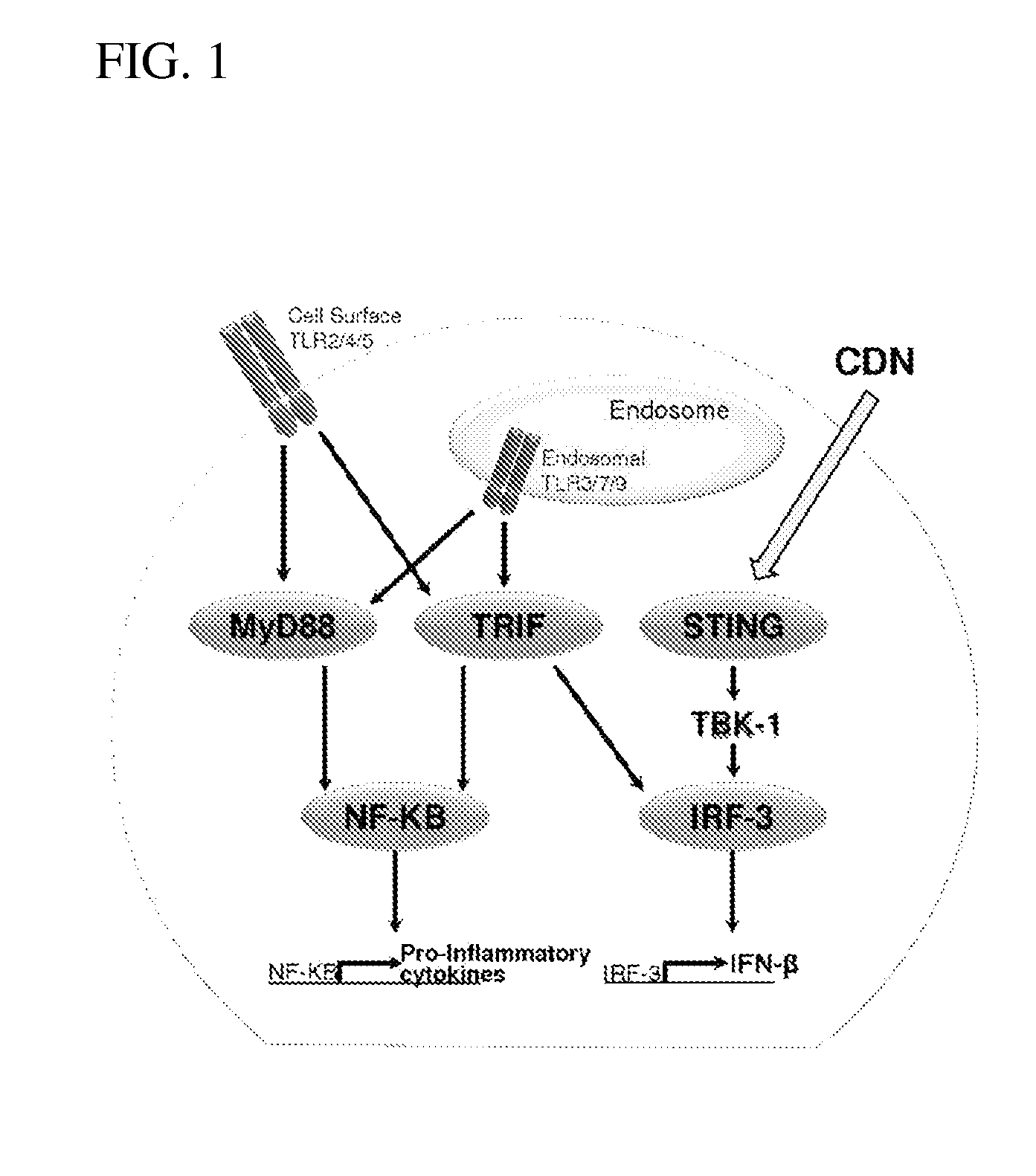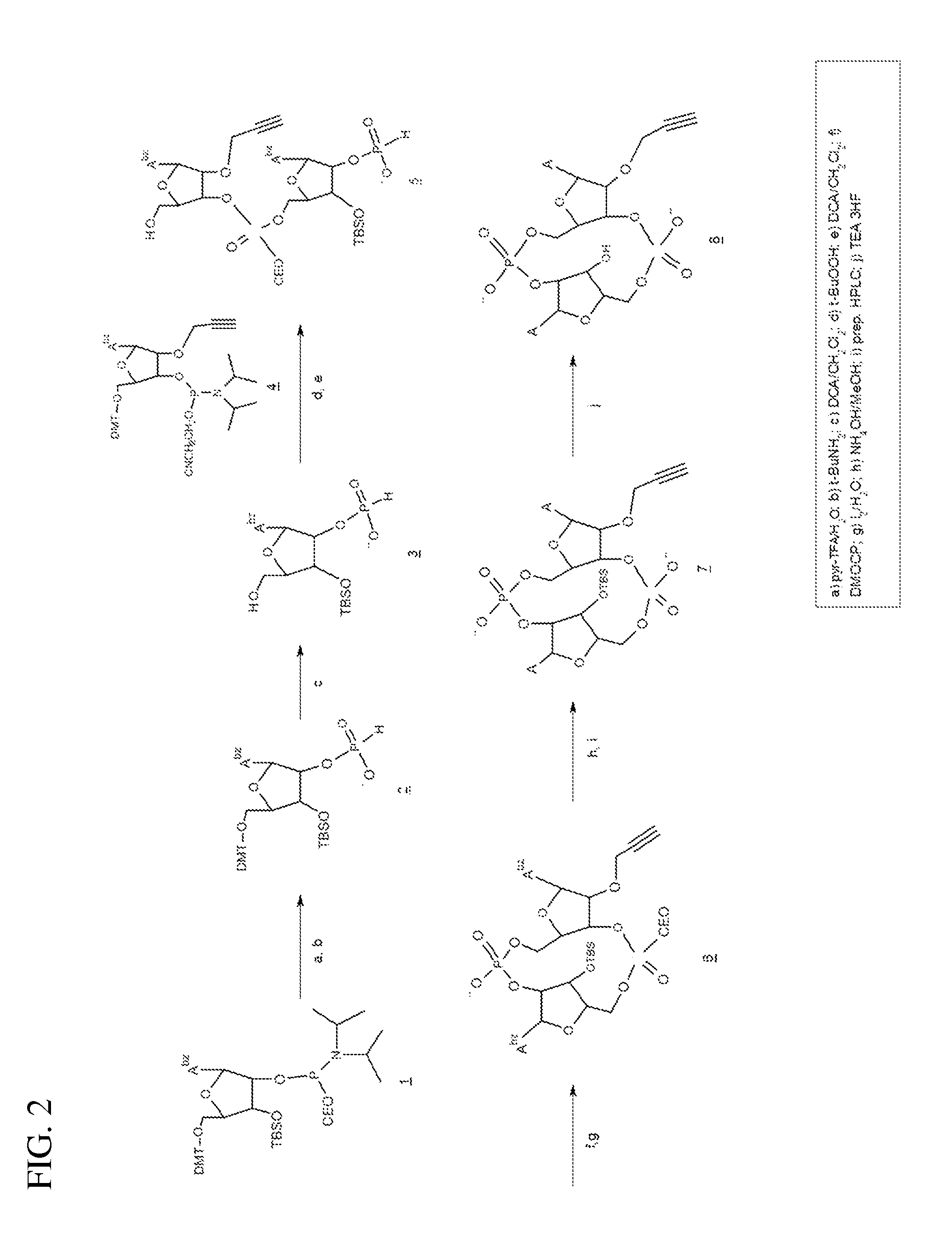Compositions and methods for inhibiting "stimulator of interferon gene" -dependent signalling
- Summary
- Abstract
- Description
- Claims
- Application Information
AI Technical Summary
Benefits of technology
Problems solved by technology
Method used
Image
Examples
example 1
General Methods
[0112]Anhydrous solvents and reagents suitable for solution phase oligonucleotide synthesis were purchased and handled under dry argon or nitrogen using anhydrous technique. Amidite coupling reactions and cyclizations were carried out in anhydrous acetonitrile or pyridine under dry argon or nitrogen. The starting materials for all reactions in dry pyridine were dried by concentration (three times) from pyridine. Preparative silica gel flash chromatography was carried out using Fluka 60A high-purity grade or Merck Grade 9385 silica using gradients of methanol in dichloromethane. Analytical HPLC was carried out on a Varian ProStar 210 HPLC system with a ProStar 330 photodiode array detector monitoring at 254 nm using a either a Varian Microsorb 10 micron C18 250×4.6 mm or a Varian 3micronC18 100×4.6 mm column and gradients of 10 mM TEAA and acetonitrile. Preparative HPLC was carried out on a Shimadzu preparative LC20-AP HPLC system, equipped with a SPD-20A UV / Vis detect...
example 2
Synthesis of 2′-O-propargyl-cyclic-A(2′,5′)pA(3′,5′)p (2′-O-propargyl-ML-CDA, structure 8), FIG. 2).
[0116]1) Preparation of 3.
[0117]To a solution of 1.7 g (1.72 mmol) N6-benzoyl-5′-O-(4,4′-dimethoxytrityl)-3′-O-tert-butyldimethylsilyl-2′-O-[(2-cyanoethyl)-N,N-diisopropylaminophinyl]adenosine (1) in 7.5 ml acetonitrile was added 0.054 ml (3 mmole) water and 0.35 g (1.8 mmole) pyridinium trifluoroacetate. After 5 minutes stirring at room temperature 7.5 ml tert-butylamine was added and the reaction stirred for 15 minutes at room temperature. The solvents were removed under reduced pressure to give 2 as a foam which was then co-evaporated with acetonitrile (3×15 ml), then dissolved in 18 ml dichloromethane. To this solution was added water (0.27 ml, 15 mmole) and 18 ml of 6% (v / v) dichloroacetic acid (13.2 mmole) in dichloromethane. After 10 minutes at room temperature the reaction was quenched by the addition of pyridine (2.1 ml, 26 mmole), and concentrated to an oil which was dried b...
example 3
Inhibition of STING-Dependent Responses
[0131]To evaluate if the antagonist 2′-O-propargyl-cyclic-[A(2′,5′)pA(3′,5′)p] (ML-propargyl-CDA) can inhibit STING-dependent induction of type I interferon induction by Rp, Rp dithio cyclic [A(2′,5′)pA(3′,5′)p] (ML RR-CDA) in human cells, 4×105 THP1-Blue™ ISG cells (a human monocyte cell line transfected with an IRF-inducible secreted embryonic alkaline phosphatase reporter gene (Invivogen) which express alkaline phosphatase under the control of a promoter comprised of five IFN-stimulated response elements) were incubated with 50 μM of Rp, Rp dithio cyclic [A(2′,5′)pA(3′,5′)p] (ML RR-CDA), 10 μM or 50 μM of the antagonist 2′-O-propargyl-cyclic-[A(2′,5′)pA(3′,5′)p] (ML-propargyl-CDA), both 50 μM Rp, Rp dithio cyclic [A(2′,5′)pA(3′,5′)p] (ML RR-CDA) and 10 μM or 50 μM 2′-O-propargyl-cyclic-[A(2′,5′)pA(3′,5′)p] (ML-propargyl-CDA), or 50 μM Rp, Rp dithio cyclic [A(2′,5′)pA(3′,5′)p] (ML RR-CDA) after a 30 min pre-incubation with 10 μM 2′-O-propargy...
PUM
| Property | Measurement | Unit |
|---|---|---|
| Immunogenicity | aaaaa | aaaaa |
| Stability | aaaaa | aaaaa |
Abstract
Description
Claims
Application Information
 Login to View More
Login to View More - R&D
- Intellectual Property
- Life Sciences
- Materials
- Tech Scout
- Unparalleled Data Quality
- Higher Quality Content
- 60% Fewer Hallucinations
Browse by: Latest US Patents, China's latest patents, Technical Efficacy Thesaurus, Application Domain, Technology Topic, Popular Technical Reports.
© 2025 PatSnap. All rights reserved.Legal|Privacy policy|Modern Slavery Act Transparency Statement|Sitemap|About US| Contact US: help@patsnap.com



